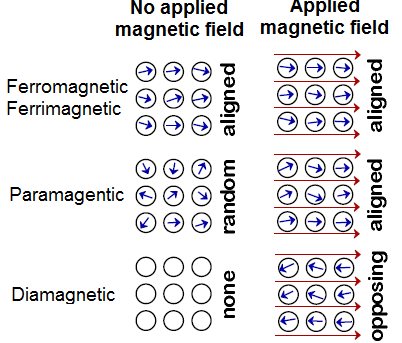Ferromagnetic Vs. Paramagnetic Vs. Diamagnetic
A magnet is a substance that can impart a detectable force to other substances without coming into direct contact with them. Magnets create a magnetic field, a force that pulls on other ferromagnetic materials, such as iron, steel, nickel, cobalt, etc. — as well as attracts or repels other magnets. Not all materials exhibit magnetic properties or are affected by magnets. To categorize a material as magnetic or non-magnetic, magnetic forces must act on it. When a bar of material is suspended in a magnetic field, it turns at a right angle or aligns with the field. Generally, all materials can be categorized as paramagnetic, ferromagnetic, or diamagnetic.
 [1]
[1]
Ferromagnetic Substance
The term "ferromagnetism" comes from the word "ferrous," which is short for iron, the first metal known to exhibit magnetic field-attractive qualities. Some materials, including iron, cobalt, alloys, etc., exhibit ferromagnetism, a characteristic magnetic behavior. Magnets are attracted strongly to ferromagnetic materials. Only magnets produce a magnetic field, they don't always create one on their own. Ferromagnetic substances merely gravitate toward magnets since magnets have a powerful pull on them. Iron, cobalt, nickel, and gadolinium are a few of the most popular ferromagnetic materials.
Further Reading: What are the Sorts of Magnetic Metals?
Paramagnetic Substance
A material is said to be paramagnetic if it aligns with the introduced field. Aluminum and air are two paramagnetic materials that have permeabilities that are somewhat higher than the permeability of space (for air, r = 1.0000004). The majority of chemical elements and some compounds are considered to be paramagnetic materials because they have a relative magnetic permeability that is slightly higher than 1 (i.e., a small positive magnetic susceptibility) and are drawn to magnetic fields.
Further reading:
Understanding Magnetism: Meaning, Mechanism, and Types
Diamagnetic Substance
When subjected to a magnetic field, all diamagnetic materials demonstrate a repelling effect. That is, magnets are repelled by diamagnetic materials. They don't show any magnet attraction. Note that most diamagnetic materials typically exhibit a weak or strong repelling action. However, some diamagnetic materials have a strong repelling behavior because they visually push away from magnets. It will appear as though other diamagnetic materials are resistant to the action of magnets. For instance, carbon and plastic are categorized as diamagnetic materials. Carbon or plastic materials pushing away from magnets are invisible. Nevertheless, they display a feeble repelling response that yanks them away from both poles on their own.
Differences Between Ferromagnetic, paramagnetic, and diamagnetic Substances
 It is common to use the terms ferromagnetic, paramagnetic, or diamagnetic to describe how a material responds to a magnetic field.
It is common to use the terms ferromagnetic, paramagnetic, or diamagnetic to describe how a material responds to a magnetic field.
- Ferromagnetic materials are attracted strongly to both magnet poles. Paramagnetic materials are only faintly drawn to one pole. Diamagnetic materials are the most unusual because they reject magnets' two poles.
- Each atom has a unique magnetic moment in paramagnetic and ferromagnetic materials.
- External Magnetic Field Behavior: diamagnetic materials have magnetic fields that point in the opposite direction from the magnetic fields around them. The magnetic fields of paramagnetic and ferromagnetic materials are aligned with the external magnetic fields.
- Magnetism Retention: When the external magnetic field is removed, diamagnetic and paramagnetic materials lose their magnetization. Ferromagnetic materials can retain their magnetic properties even in the absence of an external magnetic field.
Conclusion
Every substance possesses some form of magnetism. The classification of magnetic materials is based on their bulk susceptibility. The majority of the effects of magnetism in daily life are caused by ferromagnetism, but paramagnetism and diamagnetism are also present. If you want to learn more about magnetic materials, we would like to advise you to Stanford Magnets for more information.
Reference:
[1] Sinatra, Francy. (2010). Understanding the Interaction Between Blood Flow and an Applied Magnetic Field.














